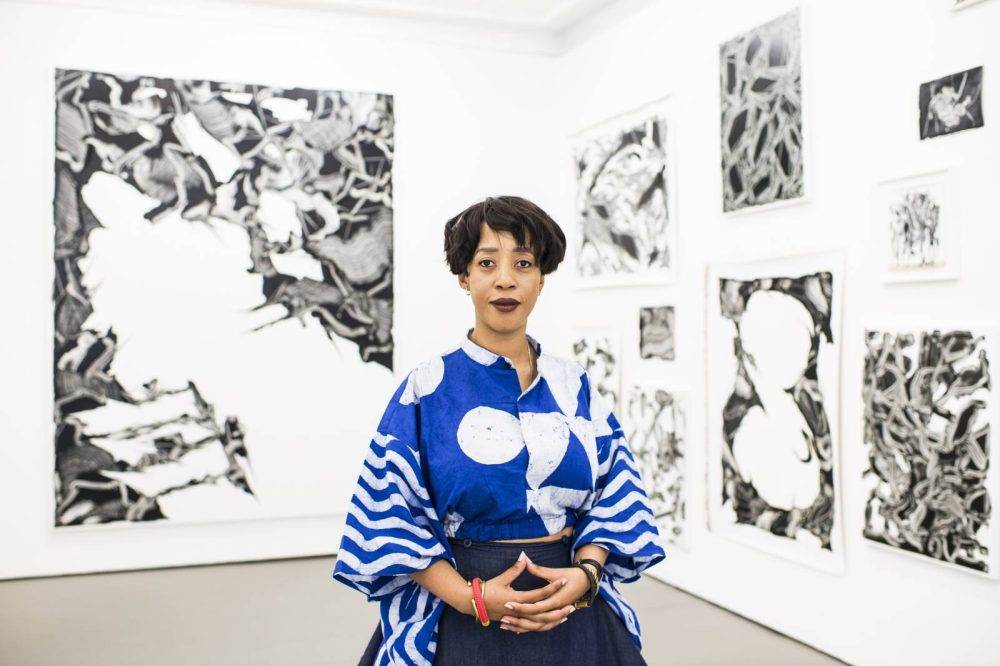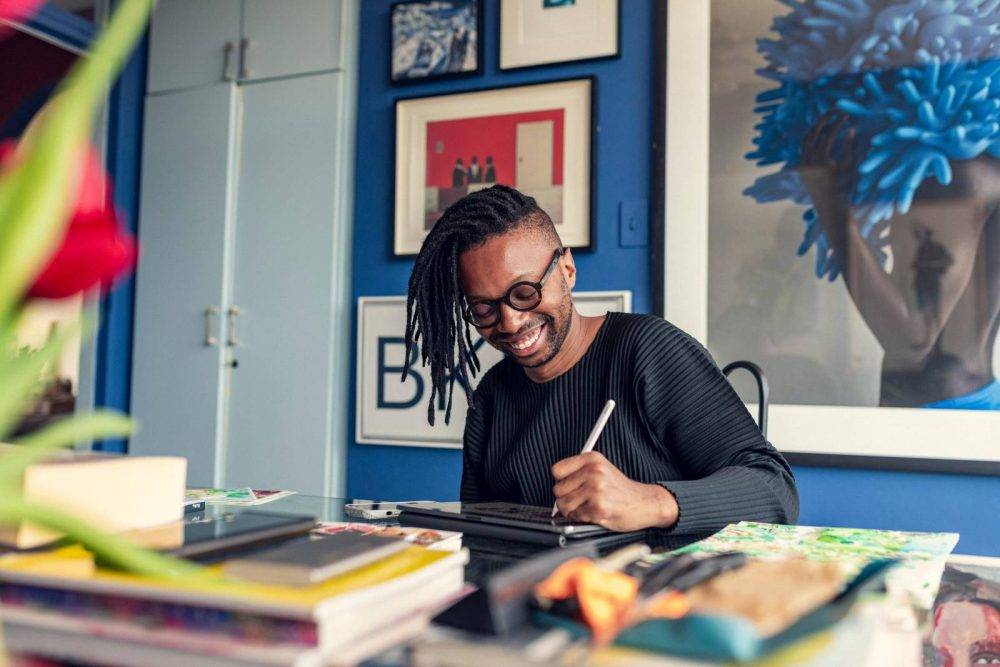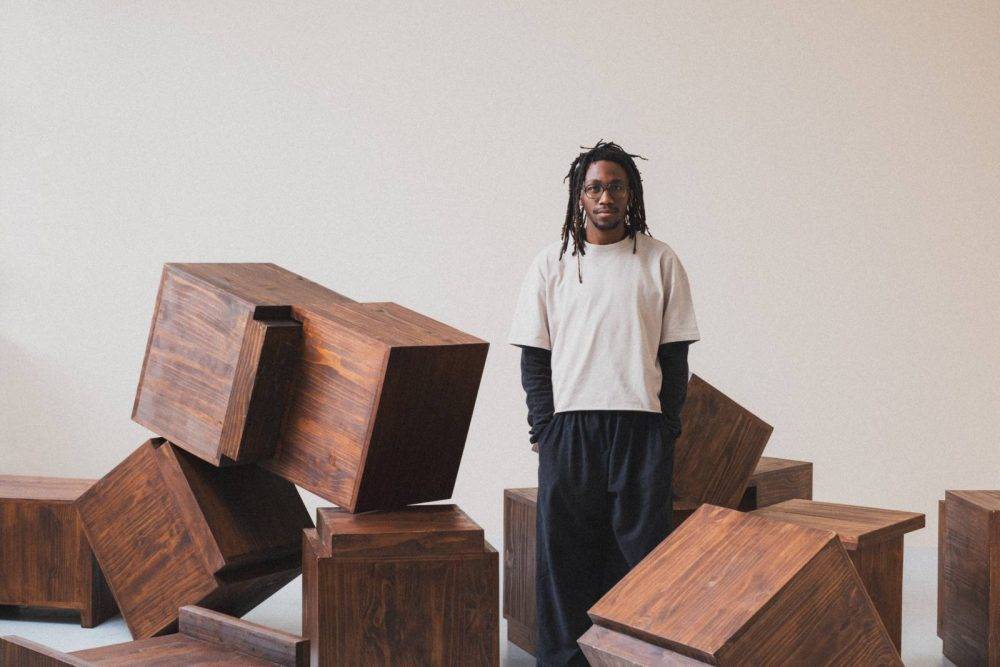
On the age of 28, Lerato Bereng was a shareholder and accomplice on the Stevenson gallery
Artwork galleries have at all times felt like sanctuaries to me — a spot to lose your self in another person’s creativeness whereas discovering one thing new about your personal.
One of many joys of residing in Rosebank, Johannesburg, is the proximity to a wealthy constellation of galleries: the Keyes Artwork Mile, dwelling to Everard Learn, Circa and Origins; the historic Goodman Gallery; David Krut Tasks and its adjoining Artwork Bookshop on Jan Smuts Avenue and, simply past, in Parktown North, the likes of Momo, Stevenson and Kalashnikovv.
But, regardless of this abundance, few of those galleries are owned by younger black individuals. For too lengthy, the artwork world has been seen because the area of previous white cash — a notion that isn’t unfounded.
Once I first moved to South Africa, almost a decade in the past, I observed this divide acutely. I’d invite pals to exhibition openings, solely to be met with well mannered however agency refusals.
They didn’t really feel welcome in these areas and who may blame them?
Galleries usually appeared like fortified enclaves, extra about exclusivity than inclusion. However I’ve observed a shift over time — a gradual, but important, reimagining of who will get to personal, create and curate on this world.
My favorite gem on the Keyes Artwork Mile is BKhz, based by multi-disciplinary artist and curator Banele Khoza when he was simply 24.
Khoza was impressed by a transformative journey to Paris in 2018, the place he accomplished a three-month artist’s residency at Cité Internationale des Arts, after successful the celebrated Gerard Sekoto Award.
Strolling by means of the historic Le Marais district, Banele was struck by a modest 40m2 gallery thriving in probably the most costly elements of town.
“That gallery left an enduring impression,” Banele remembers. “It solely displayed one art work however the intentionality behind it was unforgettable. It confirmed me you don’t want a grand house — you simply have to be deliberate about what you do with it.”
This philosophy turned the inspiration of BKhz. Each exhibition is meticulously curated, from the color of the partitions to the environment, guaranteeing every present feels distinct and deeply thought of.
“For us, it’s not about quantity, it’s about high quality. We would like each element to mirror the care and analysis we pour into our work.”
BKhz first opened its doorways in 2018 in Braamfontein, a hub for Johannesburg’s younger and inventive, earlier than relocating to the fashionable and complex Rosebank the place it re-opened in 2021.
For Banele Khoza, establishing the gallery wasn’t nearly showcasing his personal work however creating alternatives for different artists.
“I knew I wasn’t essentially the most expert within the room,” he says, humbly, “however I puzzled why others, who have been a lot extra proficient, weren’t getting the identical consideration.”
Pushed by this consciousness, Khoza used his platform to raise artists like Tatenda Chidora and Mashudu Nevhutalu, whose expertise he felt deserved larger recognition.
The gallery turned an area for celebrating and nurturing the brilliance of his friends — a tangible strategy to give again to the artwork neighborhood.
But, Khoza is candid concerning the challenges of entrepreneurship.
“There’s this power of resistance you face day by day,” he says. “You suppose, ‘I can’t do that; I ought to stop.’ It’s a continuing battle — impostor syndrome, self-doubt — however you must push by means of.”
He stresses the significance of perseverance, sharing his struggles to demystify the entrepreneurial journey: “Quitting is a part of the impediment however overcoming it’s what defines your success.”
The shortage of black-owned galleries, and their under-representation at worldwide artwork gala’s, has lengthy been a stark actuality Khoza is aware of effectively.
Whereas the numbers are slowly rising, it’s straightforward to really feel excluded from the normal artwork system. However he sees this shift as a possibility.
“What you suppose are your limits can really be your strengths,” he displays, noting limitation usually sparks creativity, a significant asset in a area the place innovation is the driving pressure.
“I’d additionally simply encourage angel traders to tackle entrepreneurs within the artwork house at an earlier stage, as a result of in case you have the suitable investor behind you, they might additionally make it easier to with mentorship and to plot methods that help you to remain in enterprise,” he provides.
Final 12 months, Khoza says, was a turning level for him in understanding the artwork enterprise.
“The artwork world actually shifted economically in 2024,” he explains. Gross sales weren’t as predictable and plenty of galleries, together with in New York, closed their doorways as a result of these modifications.
This was a wake-up name to rethink what it means to run a gallery in such an atmosphere. As each an artist and gallery proprietor, he has reinvested his earnings in BKhz, embracing the challenges of entrepreneurship with a way of resilience and creativity.
BKhz has develop into a launchpad for a number of the most enjoyable voices in up to date South African artwork. Amongst its distinguished previous exhibitors is Lunga Ntila, who died in 2022, a celebrated multidisciplinary artist who was identified for her putting digital collages that explored identification and tradition.
Notably, Ntila was the primary artist at BKhz to debut with a solo present quite than beginning with a gaggle exhibition — testomony to Khoza’s perception in her distinctive imaginative and prescient.
Zandile Tshabalala, whose vibrant figurative work celebrating black womanhood had already garnered worldwide acclaim in Germany, additionally had her South African debut at BKhz.
Khoza’s gallery offered a homecoming stage for her, affirming its function in connecting world recognition with native audiences.
Wonderbuhle, a rising star identified for his emotive and textured storytelling by means of blended media, has exhibited at BKhz twice and has additionally showcased his work on world phases.
Most lately, the gallery welcomed Nelson Makamo, considered one of South Africa’s most revered up to date artists, identified for his dynamic portraits that centre the great thing about African youth.
By these collaborations, BKhz continues to place itself as each a nurturing floor for rising expertise and a outstanding house for established artists to experiment and join, seven years since its institution.

Artwork on the transfer
Lebo Kekana is an revolutionary 24-year-old who didn’t enable the prohibitive value of paying for a bodily house cease him from pursuing his gallery aspirations. 4 years in the past, he established what he describes as a “nomadic curatorial venture” known as Fede Arthouse.
His is an artwork gallery that exists with out a everlasting house and as an alternative hosts exhibitions by means of collaborations with different galleries.
Rising up on Johannesburg’s East Rand, Kekana wasn’t uncovered to the artwork world however a transfer to Cape City opened his eyes.
“Once I began going to galleries in Cape City, I realised this was a factor,” he explains.
Regardless of missing a proper arts background, he determined to create an area for younger individuals like himself.
“I didn’t research the humanities in any respect,” he says. “I used to be a pc science scholar once I felt the necessity to exist within the artwork world.”
It was throughout one of many Covid lockdowns that Kekana discovered the liberty to discover his rising curiosity in artwork.
“I began portray and realised how a lot I actually loved it,” he remembers. “I wished to pursue it severely.”
In 2020, he rented a home within the Woodstock neighbourhood of Cape City and reached out to different rising artists to create his first present. Fede Arthouse started its journey in December 2020, with a present that set the tone for what was to come back.
“I didn’t name myself a curator on the time,” he says, “however that’s when it started.”
By the next 12 months, Kekana had dropped out of college to totally concentrate on Fede and his mission to make artwork extra accessible.
“I wished to create one thing that felt comfy for me and for others like me. I didn’t need the everyday white-cube gallery vibe, the place individuals who appear to be me aren’t positive in the event that they belong.
“The concept of a home with a lounge and a again backyard was already fairly comfy, simply by advantage of it being a home house.
“That’s the place the identify Fede Arthouse got here up — simply from that first present taking place in the home. It simply felt prefer it made sense and it sort of caught.
The phrase “fede” comes from Tsotsitaal slang, which means “all good”, and generally used as a response to a greeting.
“I used to be impressed by a gallery I noticed on-line that’s based mostly in Mexico that was known as a nomadic gallery,” says Lebo. “I assumed it was an attention-grabbing idea, particularly since I didn’t have a everlasting house.
“I made a decision to roam round, bringing the reveals to completely different areas. If the gallery existed anyplace, calling it Fede would act as an identification marker, giving it a way of origin.
“Similar to Tsotsitaal can range barely throughout South Africa, Fede’s reveals would tackle completely different feels, relying on the place they have been.”
Twenty twenty-one was a 12 months of experimentation as Kekana navigated the complexities of curating.
By 2022, the gallery had held two extra reveals and, in 2023, Fede occupied a constructing for six months, permitting Kekana to discover his curatorial language extra deeply.
Throughout that point, Fede additionally hosted a residency for 3 Cape City artists: Zimbabwean-born photographer Micha Serraf, multidisciplinary artist Cira Bunsby and the cultural expressionist painter David Goldsmid.
“Not having a everlasting house turned a bonus,” Lebo displays.
“Each exhibition could be completely different and I may collaborate with different galleries or cultural areas.
“It was a brand new strategy to have interaction, the place Fede got here in because the curatorial physique with artists in tow.”
Fede has ventured internationally, with reveals in Ibiza and Barcelona, in Spain, and even a presentation at Decorex in South Africa.
By final 12 months, Fede’s attain had expanded additional, showcasing its versatility throughout disciplines from tremendous artwork to design and movie.
The gallery made its mark on the RMB Latitudes Artwork Honest and is about to construct a extra constant programme in Johannesburg.
“I reside in Joburg now with the intention of doing extra reveals within the metropolis,” Kekana shares, emphasising his want to domesticate a dynamic arts neighborhood throughout each cities.
Regardless of the challenges that go along with constructing a sustainable mannequin, Kekana is set.
“There are discussions that have to occur with galleries about honest curatorial charges,” he displays, noting that his focus is on rising Fede’s impression past the confines of the normal gallery house.
By collaborations with galleries like Clean Tasks, Lemkus and Below Tasks, in addition to Kekana’s involvement in high-profile occasions akin to RMB Latitudes, Fede continues to push boundaries, guaranteeing that artwork in South Africa just isn’t confined to a privileged few.

Reworking from inside
Beginning as a younger curator on the Stevenson in Johannesburg in 2011, Lerato Bereng rapidly made her mark, turning into a shareholder and accomplice on the gallery by 2014, at simply 28 years previous. This was a groundbreaking achievement in an area that was nonetheless largely exclusionary.
“By way of black possession of artwork galleries in South Africa, it was few and much between again then,” Bereng remembers. “Notably as a black girl. I don’t know that there was one other like me. So, yeah, it was sort of a giant second for myself.”
Her entry into the artwork world started with the Cape Africa Platform’s Younger Curators Programme, the place she was chosen as considered one of 5 trainees for an 18-month programme that culminated in curating her first exhibition. “That was the place every part began,” she says.
This early expertise ready her for an invite to curate a present at Stevenson Cape City, then known as Michael Stevenson, following her work on the Cape City Biennial.
Reflecting on her rise, Bereng emphasises the distinctiveness of Stevenson’s construction, which allowed her to develop right into a directorship function.
“The construction on the time didn’t actually exist elsewhere. It was uncommon to see power-sharing in galleries.
“Often, the identify on the door is the only proprietor and the administrators simply work there,” she explains.
At Stevenson, nonetheless, 11 companions share possession, a mannequin that challenges conventional hierarchies. Three of these companions are black girls.
Established in 2003 in Cape City, Stevenson now additionally has galleries in Johannesburg and Amsterdam.
Bereng’s story coincides with important shifts in South Africa’s artwork scene. When she started her profession, it lacked non-commercial areas and the museums struggled with funding.
“Galleries performed a little bit of a museum function again then,” she notes. “They have been those bringing way more formidable programming and introducing worldwide artists to South Africa as a result of the museums merely didn’t have the monetary capacity to do it — and plenty of nonetheless don’t.”
This dynamic gave Bereng and her friends a novel alternative to redefine roles within the business.
“It was thrilling to be in an area the place every part was in flux. I favored that it allowed me the liberty to think about what I may contribute.
“I may have by no means imagined being at a business gallery however Stevenson turned an area the place I may experiment.”
Nonetheless, the insular tendencies of the normal gallery and museum fashions stay a problem.
“The gathering and museum fashions we see at present are based mostly on Western buildings. They’re nonetheless seen as very white, elitist and exclusionary,” Bereng acknowledges.
“We don’t assist ourselves with the impenetrable artwork historical past language, both. Artwork-speak could make individuals really feel dumb and that’s an enormous barrier to engagement.”
But, she sees hope within the new era’s capacity to problem these norms.
“Areas like BKhz are good. They’re breaking down these limitations. Youthful artists and curators are adopting extra versatile, revolutionary fashions — like pop-ups, on-line platforms and artist-run initiatives.
“The nomadic curatorial venture idea of a Fede Arthouse can also be an excellent instance of what’s potential.”
At Stevenson, Bereng has championed initiatives such because the Stage venture, designed to highlight unrepresented younger artists alongside established names.
“We wished to create an area with no stress or expectations. It’s about giving younger artists an opportunity to experiment and be taught, with help from the gallery,” she explains.
These efforts have additionally cultivated a brand new wave of black artwork collectors.
“By Stage, we’ve seen younger collectors who’re excited to interact. They’re, like, ‘Oh, I can afford this — it’s possibly R5 000. Can I do a lay-by?’ It has been good to interact with them on these phrases, utilizing new language.”
Regardless of the successes, Bereng acknowledges that systemic challenges persist.
“One purpose we don’t see extra black-owned galleries is that it’s a tricky business. Financially, it requires quite a bit.
“Traditionally, many black individuals in South Africa don’t come from wealth, so with out robust monetary backing, it’s onerous to maintain a gallery.
“It took Michael Stevenson years to interrupt even.”
However she encourages younger individuals to dream massive.
“I’m so taken by the youthful era. They simply go for it! Individuals like Banele Khoza and Lebo Kekana determined what they wished and made it occur. That’s what it takes — simply do it in a approach that’s honest and comes from your personal expertise.”